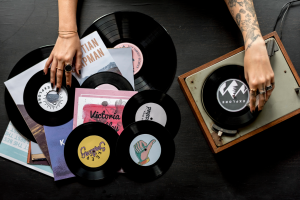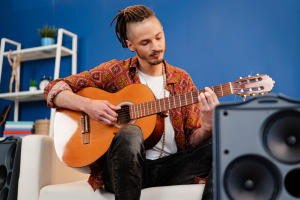The landscape of music education, like many other fields, has been dramatically reshaped by the advent and evolution of technology. Traditional methods of music education, rooted in face-to-face instruction, sheet music, and physical instruments, have given way to a new era marked by digital platforms, interactive apps, and virtual reality experiences. This transformation is not merely a shift in tools and techniques, but a profound revolution in how we approach and understand music education.
In the past, learning to play an instrument or studying music theory required access to specialized teachers, expensive resources, and often, a significant investment of time. The classroom, be it a private studio or a school music room, was the primary, if not the sole, venue for instruction.
However, the rise of technology has challenged these traditional norms and opened up exciting possibilities. Today, online learning platforms and educational apps are democratizing music education, breaking down geographical and socio-economic barriers. Virtual and augmented reality technologies are offering immersive experiences that enrich understanding and enhance engagement.
This article aims to explore this fascinating intersection of music and technology, shedding light on how modern innovations are revolutionizing music education. We will delve into the impact of these changes, evaluating the benefits and challenges they present, and gaze into the crystal ball to anticipate what the future might hold.
The Revolution in Teaching Methods
In the traditional classroom, music education largely revolved around one-on-one instruction, group classes, and ensemble rehearsals. However, the recent technological revolution has significantly reshaped the methods of teaching music.
One of the most transformative changes we’ve seen is the emergence of online learning platforms. Websites and apps like Yousician, Simply Piano, and Soundtrap offer a range of lessons for various instruments and skill levels, allowing students to learn at their own pace and in their own space. These platforms provide interactive exercises, instant feedback, and progress tracking, making learning more engaging and personalized than ever before.
Moreover, virtual reality (VR) and augmented reality (AR) technologies have started to make their mark on music education. With VR, students can immerse themselves in a virtual concert or a recording studio, gaining insights into real-world musical scenarios. AR, on the other hand, can overlay digital information onto physical instruments, guiding students through complex pieces or techniques.
Furthermore, technology has enabled remote collaborative experiences. Online ensemble platforms let musicians from different geographical locations perform together in real time, fostering a sense of community and collaboration despite physical distances.
These innovations are not just supplementing traditional methods, they’re revolutionizing them. They’re offering new ways to inspire, educate, and empower aspiring musicians, democratizing access to quality music education.
The Impact of Technology on Accessibility
The democratization of music education through technology has been nothing short of revolutionary. In the past, access to quality music education often hinged on factors such as geographical location, financial capacity, or the availability of skilled teachers. Today, however, advancements in technology have significantly widened the access to music education, making it more affordable and accessible than ever before.
One of the most transformative aspects of this revolution is the rise of online learning platforms and educational apps. Websites like Coursera and Udemy offer a myriad of music courses that cater to various skill levels and musical interests. Apps such as Yousician and Simply Piano allow aspiring musicians to learn at their own pace, with interactive lessons and instant feedback mechanisms. These platforms not only offer flexibility in terms of time and pace but also eliminate geographical constraints, enabling anyone with internet access to learn music.
Furthermore, the advent of affordable music production software and digital audio workstations has made it possible for individuals to experiment with creating and recording their own music from the comfort of their homes. This has significantly reduced the entry barriers to music production, which was once an expensive endeavor reserved for professionals with access to high-end studios.
Despite these advancements, it’s crucial to acknowledge that digital divide still exists, and not everyone around the globe has equal access to these technological resources. But the trajectory is promising, and as technology continues to evolve and become more ubiquitous, the hope is that quality music education will be within everyone’s reach.
The Advantages and Challenges of Tech-based Music Education
The integration of technology into music education presents a host of advantages that are propelling the industry into new and exciting directions. First and foremost, it has democratized access to music education. With online platforms and educational apps, anyone with an internet connection can now learn music, regardless of their geographical location or financial status. This has opened up opportunities for people who previously may not have had the means to engage in formal music education.
In addition, technology has made learning more interactive and engaging. Augmented and virtual reality tools offer immersive experiences that can make learning music more enjoyable and less intimidating. Digital software allows students to experiment with different sounds and compositions, fostering creativity and innovation. Furthermore, online platforms provide immediate feedback, enabling students to identify and rectify their mistakes quickly.
However, despite these benefits, there are also challenges that need to be addressed. One significant concern is the digital divide. Not everyone has access to the necessary devices or a reliable internet connection to take advantage of these resources. There’s also the issue of maintaining motivation when learning remotely, as the lack of face-to-face interaction can sometimes lead to feelings of isolation. Lastly, while technology can offer invaluable tools for learning, it cannot entirely replace the nuanced feedback and personal connection that come from a live teacher-student relationship.
Future Perspectives
As we look towards the future, it is clear that technology will continue to play a pivotal role in reshaping music education. The possibilities are as diverse and dynamic as the field of technology itself.
One exciting frontier is the realm of Virtual Reality (VR) and Augmented Reality (AR). These technologies offer immersive environments where students can practice and perform in simulated settings. Imagine a student violinist being able to rehearse with a virtual orchestra or a budding pianist practicing on a grand piano in a simulated concert hall. The psychological impact of such experiences could greatly enhance learning and motivation.
Artificial Intelligence (AI) also holds significant promise. AI-driven software could provide personalized instruction, adapting to a student’s pace and style of learning. It could identify areas of weakness and customize exercises to address them, making practice sessions more productive.
Blockchain technology, too, could revolutionize how we access and share music resources. It could enable the creation of a decentralized, global library of music scores, recordings, and instructional materials, accessible to all.
Finally, advancements in data analytics could allow teachers to track students’ progress in real time, pinpointing areas of improvement with precision and speed.
While these predictions may seem like science fiction, they are closer to reality than we might think. The key will be to harness these technologies in ways that enhance, rather than replace, the human element in music education. After all, music is a profoundly human endeavor, and its ultimate goal is to touch hearts and souls.
To Sum It Up
The digital revolution in music education is undeniably here, and it’s transforming how we learn, play, and experience music. By leveraging online platforms, VR/AR technologies, and remote collaboration tools, we’re breaking down barriers, democratizing access, and fostering a new generation of musicians who are as comfortable with a digital audio workstation as they are with a traditional instrument.
However, this journey doesn’t end at learning an instrument or mastering a piece of music. For many, the next step is to share their creations with the world, and technology is equally transformative in this realm.
Novecore is a platform that empowers musicians to distribute their music for free on all major platforms. Whether you’re a budding artist looking to share your first composition or an experienced musician ready to reach a wider audience, Novecore provides an easy, effective, and cost-free solution.
In conclusion, the marriage of music and technology has brought about a revolution that extends beyond teaching methods and into the realms of creation and distribution. Embracing these advancements can truly take your musical journey to new heights. Start today by signing up for free with Novecore and let the world hear your music.



